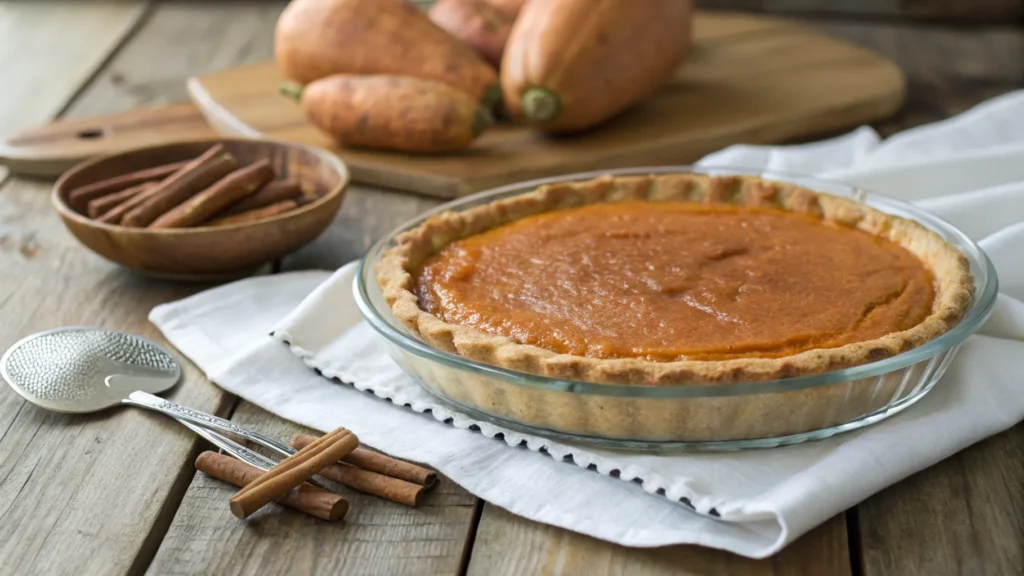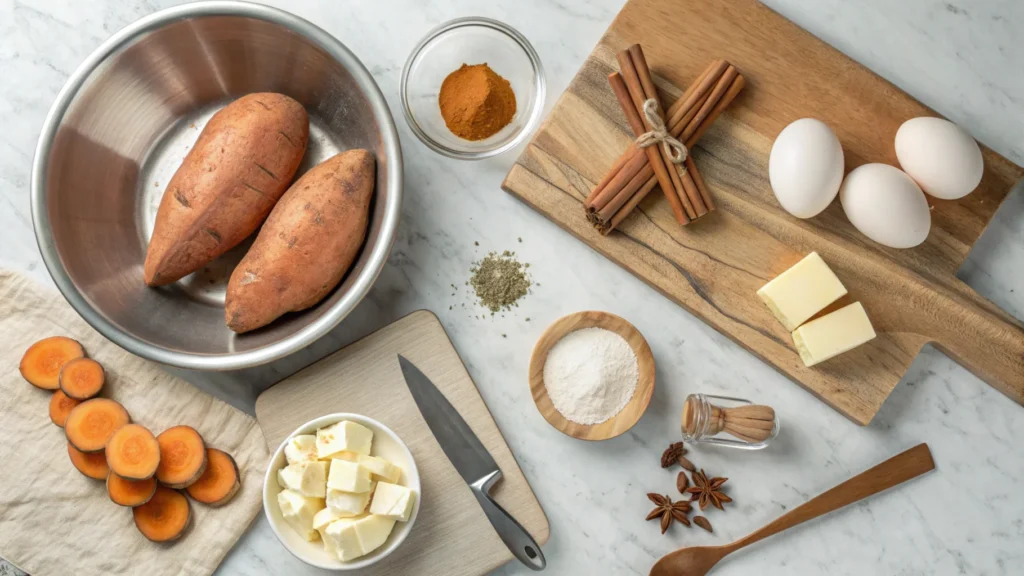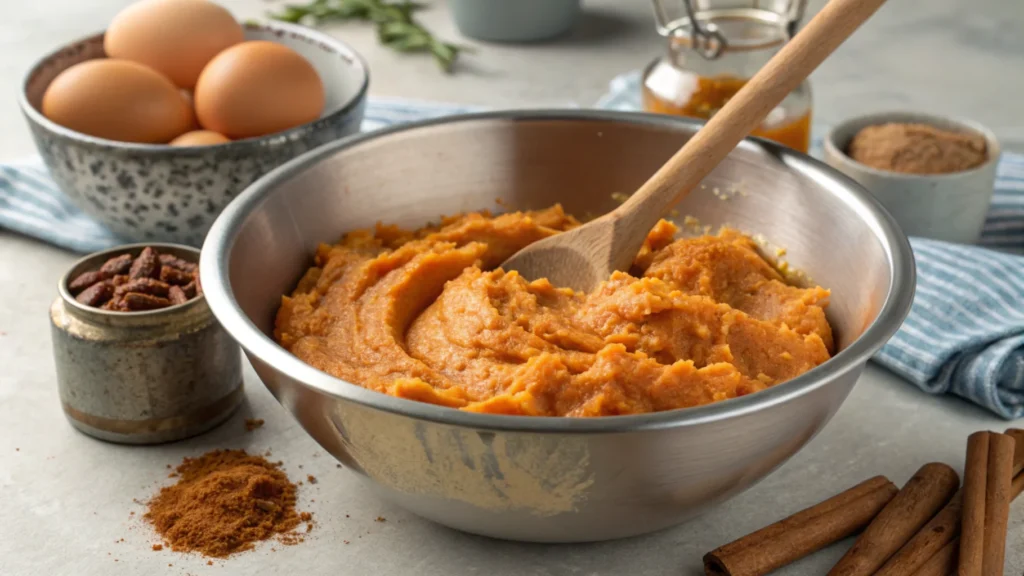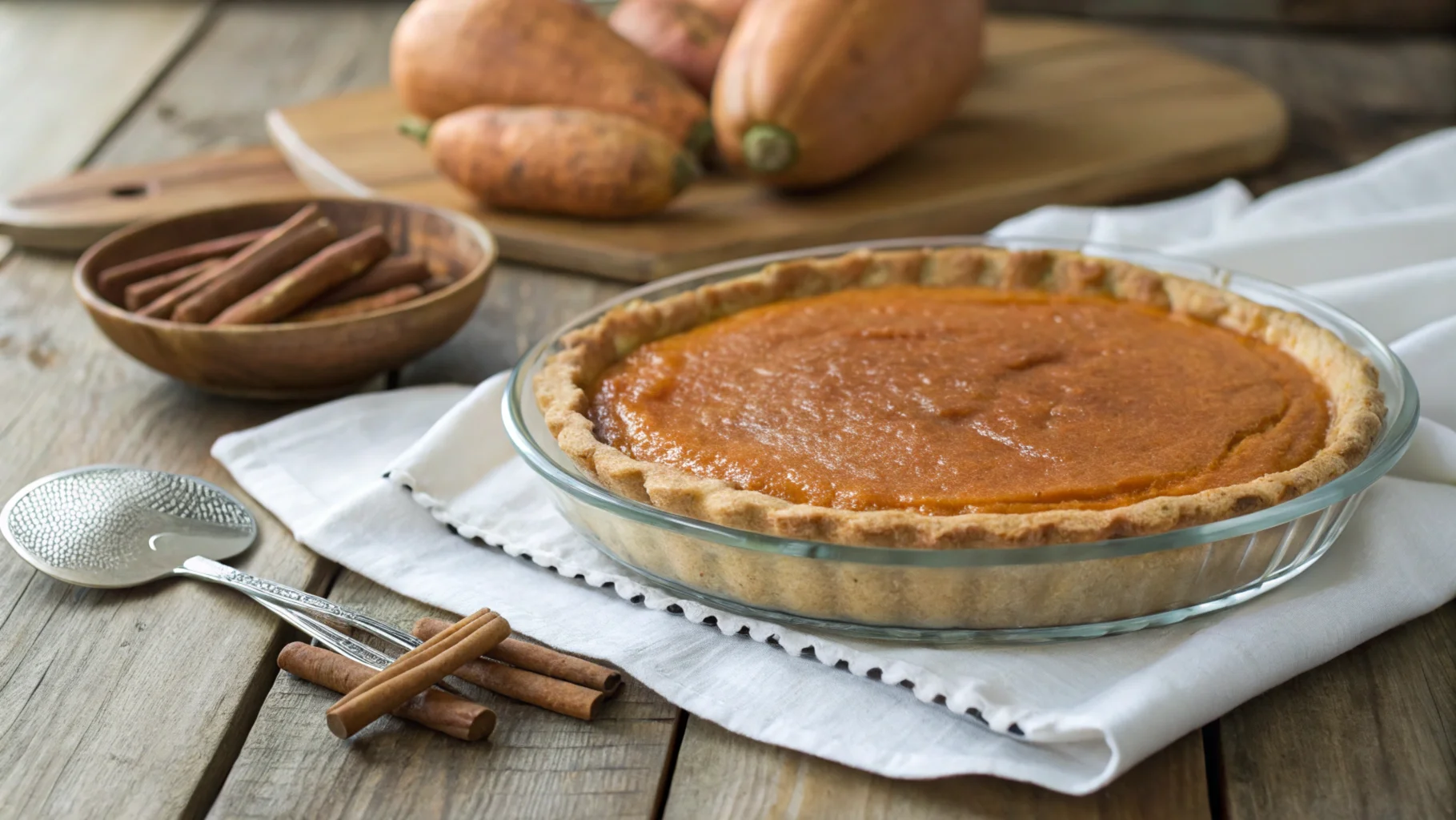People love sweet potato pie for its rich, comforting flavor. The natural sweetness of the sweet potato blends with spices like cinnamon and nutmeg, enhancing the sweet potato pie taste. This creates a warm, inviting flavor that’s uniquely delicious. This dessert’s silky smooth filling is complemented perfectly by a flaky, buttery crust, making it a delightful treat.
A key element of sweet potato pie’s flavor is the sweet potato. It provides a mild, earthy sweetness. This is often enhanced with a touch of sugar, adding depth to the flavor profile. The spices are equally important. They add complexity and balance to the sweetness, making the pie memorable.
For those interested in crafting this classic dessert at home, you can explore an Easy Step-by-Step Guide on How to Make Sweet Potato Pie From Scratch. This comprehensive guide provides everything you need to know, from preparing the sweet potatoes to perfecting the buttery crust.

Table of Contents
Sweetness: Natural vs. Added Sugar in Sweet Potato Pies
A key component of sweet potato pie is its sweetness. Many people wonder, what does a sweet potato pie taste like when it uses different sources of sugar. Naturally, sweet potatoes are quite sweet on their own, but additional sugar is often incorporated to elevate the flavor. To learn more about the best methods for preparing sweet potatoes, check out Is It Better to Bake or Boil Sweet Potatoes for Pie? Best Method Explained.
- Natural Sweetness: The natural sugars in sweet potatoes give the pie a mild, subtle sweetness. When baked, the natural sugars caramelize, contributing to the pie’s depth of flavor.
- Added Sugar: Many recipes call for granulated sugar, brown sugar, or even maple syrup to boost the sweetness. These sugars add complexity, often providing a richer sweetness compared to the natural sugar in the potatoes.
Whether you use only natural sugars or a blend, the sweet potato pie taste remains delicious. However, the level of sweetness can vary.

The Role of Spices: Cinnamon, Nutmeg, and Beyond
When it comes to what does a sweet potato pie taste like, spices are often the unsung heroes. Cinnamon, nutmeg, and other warm spices contribute to the depth and complexity of the pie’s flavor profile. Without them, the pie would taste quite plain, lacking the cozy warmth that makes it so irresistible.
- Cinnamon: This spice is a key ingredient in sweet potato pie. It adds a sweet, woody flavor with subtle heat that enhances the overall flavor.
- Nutmeg: Nutmeg, with its slightly musky and sweet flavor, complements cinnamon, creating a complex blend that makes the pie so comforting.
- Other Spices: Some recipes also incorporate ginger, allspice, or cloves, each adding their own nuances to the flavor.
The careful use of these spices elevates the sweet potato pie taste, making it a warm, inviting dessert perfect for cooler months.
The Creamy Texture and Mouthfeel of This Dessert
Another essential characteristic of sweet potato pie is its creamy texture, which provides a delightful contrast to the buttery crust. Blending mashed sweet potatoes with butter, cream, and sometimes eggs achieves the filling’s smooth, velvety texture.
- Rich and Smooth: The sweet potato itself, when cooked properly, has a soft and smooth texture that blends seamlessly with the other ingredients, creating a luxurious mouthfeel.
- Creaminess: The addition of heavy cream or half-and-half enhances the smooth texture of the pie, making each bite feel indulgent.
- Eggs: Eggs contribute to the structure of the filling while adding a slightly firm texture, providing a silky consistency.
These elements create a mouthwatering balance between rich creaminess and a flaky crust. This makes sweet potato pie a truly unique dessert.

Sweet Potato Pie vs Pumpkin Pie: A Flavor Showdown
Both sweet potato pie and pumpkin pie share similarities, but they each bring a distinct flavor to the table. While the texture of both pies is smooth and creamy, their flavors diverge in interesting ways.
- Sweet Potato Pie: As mentioned, sweet potato pie has a mild sweetness with earthy undertones. The spices, such as cinnamon and nutmeg, complement the flavor, but the sweet potatoes themselves contribute a smoother and softer texture.
- Pumpkin Pie: Pumpkin pie tends to have a more pronounced spiced flavor and is often slightly more savory in taste. The pumpkin’s flavor is earthier, and it may require more added sugar to match the sweetness of sweet potato pie.
Both pies have their place in the fall and holiday seasons, but sweet potato pie is known for its rich, velvety texture and slightly sweeter, more subtle flavor profile.
The Buttery Crust: Complementing Sweet Potato Filling
The crust of sweet potato pie is another essential element that contributes to its overall taste. The flaky, buttery crust balances the richness of the sweet potato filling, creating a harmonious bite with every forkful.
- Buttery Flakiness: The crust of sweet potato pie should have a light and crisp texture, complementing the smooth filling without overpowering it.
- Complementary Flavors: The butter in the crust not only contributes to the texture but also enhances the flavor of the pie. The savory, slightly salty notes from the crust create a perfect contrast to the pie’s sweet filling.
The rich filling and flaky crust make sweet potato pie a delightful treat. Without the proper crust, the experience wouldn’t be the same.
How Sweet Potatoes Enhance the Flavor of This Dessert
Sweet potatoes are the star ingredient in sweet potato pie, and they contribute much more than just sweetness. When baked, the natural sugars in the sweet potatoes intensify, creating a deep, caramel-like flavor. Additionally, the earthy undertones of the potatoes serve as the perfect base for the spices added to the pie.
- Sweetness: As mentioned, sweet potatoes have a subtle sweetness that provides the pie’s main sugar source. This natural sweetness is key to making the pie stand out.
- Texture: The smooth, soft texture of the sweet potato flesh creates a creamy filling, which pairs beautifully with the crunchy crust.
- Flavor: The sweet potato’s earthy and nutty flavor serves as a neutral base, allowing the spices to shine without overpowering the pie.
In short, the sweet potato’s contribution is crucial to both the flavor and texture of the pie, making it one of the most beloved desserts.
Variations in Sweet Potato Dessert Recipes
Sweet potato pie is incredibly versatile, and many variations exist depending on personal preferences or regional influences. While the basic ingredients remain the same, the flavors and techniques can differ greatly.
- Crust Variations: Some recipes use a traditional flaky pie crust, while others may opt for a graham cracker crust or even a nut-based crust for added texture.
- Spice Adjustments: The amount of spices used can vary. For instance, some people might prefer a stronger nutmeg flavor, while others may opt for a more cinnamon-forward taste.
- Add-ins: Some recipes incorporate other ingredients, such as vanilla extract, brown sugar, or maple syrup, to adjust the pie’s sweetness and flavor.
No matter the variation, sweet potato pie invites creativity. It allows endless tweaks to suit every taste.
Sweet Potatoes: Dessert or Side Dish?
Sweet potato pie is often seen as a classic dessert, but its role can extend beyond just being a sweet treat. In some cultures, it is served as a side dish at Thanksgiving or other festive gatherings.
- Dessert Role: Traditionally, sweet potato pie is served as a rich, dessert item after a hearty meal, often enjoyed with whipped cream or ice cream.
- Side Dish Role: In some regions, sweet potato pie can also be considered a side dish, particularly if it has a less sweet flavor profile, or is served alongside other savory dishes.
In both cases, its comforting flavor and rich texture make it a welcome addition to any table.
Regional Influences on the Flavors of This Dessert
The flavor of sweet potato pie can vary significantly depending on the region. Different areas may emphasize particular ingredients, spices, or techniques that shape the final taste.
- Southern Influence: In the Southern United States, sweet potato pie is often a beloved holiday dessert, typically characterized by a rich, spiced flavor and a flaky crust.
- Caribbean Influence: In the Caribbean, sweet potato pie might incorporate ingredients like coconut milk, rum, or lime zest, adding unique flavors to the traditional pie.
- Other Regional Variations: Depending on the region, sweet potato pie may also include local variations like pecans, chocolate, or even ginger for a unique twist.
These regional differences make sweet potato pie a versatile and culturally significant dish.
Tips for Enhancing the Flavor of Sweet Potato Pie
While sweet potato pie is already flavorful on its own, there are several ways to enhance its taste and make it even more irresistible.
- Use Fresh Sweet Potatoes: Opting for fresh sweet potatoes instead of canned can greatly improve the flavor and texture of your pie.
- Add a Touch of Citrus: A hint of lemon or orange zest can brighten the pie’s flavor, balancing out the richness of the sweet potatoes.
- Spice Adjustment: If you want a more intense flavor, try adjusting the spices. Add a little extra cinnamon, nutmeg, or even ginger for a more complex profile.
By experimenting with these tweaks, you can elevate your sweet potato pie to new heights.
The Emotional and Cultural Significance of Sweet Potato Pie
Sweet potato pie carries deep emotional and cultural significance, particularly in Southern and African American traditions. For many, it is more than just a dessert; it is a symbol of family, heritage, and celebration.
- Holiday Tradition: Many families pass down recipes from generation to generation, making sweet potato pie an essential part of family gatherings and holidays like Thanksgiving.
- Cultural Symbol: For African Americans, sweet potato pie has been a symbol of resilience and cultural identity, often appearing in both festive and everyday meals.
Thus, sweet potato pie is a dish filled with more than just flavor – it carries memories and stories that make it truly special.
FAQs About Sweet Potato Pie Taste
What does sweet potato pie taste like?
Sweet potato pie has a rich and earthy flavor, complemented by a natural sweetness from the sweet potatoes. The taste is smooth and comforting, with a slight spice profile coming from ingredients like cinnamon and nutmeg. The combination of the creamy texture and the buttery crust makes each bite indulgent and satisfying.
Does sweet potato pie taste the same as pumpkin pie?
While both pies share a similar texture, sweet potato pie has a sweeter and smoother flavor compared to pumpkin pie. Pumpkin pie is typically earthier and more savory, whereas sweet potato pie leans more on the natural sweetness of the potatoes and a creamy texture. Both pies are spiced with cinnamon and nutmeg, but the flavor balance differs.
What does sweet potato taste like?
Sweet potato has a naturally sweet, earthy flavor, which can vary slightly depending on the variety. The flesh is often creamy when cooked, with a smooth and somewhat nutty taste. When baked, the sugars caramelize, enhancing its sweetness and making it the perfect base for dishes like sweet potato pie.
Why is sweet potato pie so popular?
Sweet potato pie is popular for its comforting flavor, smooth texture, and rich, spiced taste. It’s a beloved dessert in many cultures, particularly in the South, where it’s often served during holidays and family gatherings. The combination of the natural sweetness of the sweet potatoes and the warm spices makes it an irresistible and nostalgic treat, perfect for cozy occasions.
Conclusion
Sweet potato pie offers a delightful blend of flavors, textures, and cultural importance. Its creamy filling, rich with the natural sweetness of sweet potatoes, pairs harmoniously with spices like cinnamon and nutmeg. A buttery, flaky crust complements the filling, making it an all-time favorite dessert or side dish. This versatile pie, loved for its sweet and spiced profile, remains a comforting classic across generations.
Interestingly, preparing sweet potatoes plays a significant role in enhancing their flavor and texture. For example, soaking sweet potatoes before baking is a widely used technique that offers scientific benefits. To explore these advantages and learn practical tips, check out the detailed guide on Why Do You Soak Sweet Potatoes Before Baking? Science & Tips Explained. This resource dives into how soaking improves texture, reduces cooking time, and enhances sweetness, ensuring your sweet potato pie turns out perfectly.

